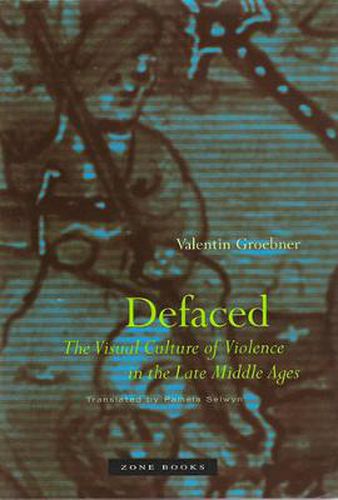Readings Newsletter
Become a Readings Member to make your shopping experience even easier.
Sign in or sign up for free!
You’re not far away from qualifying for FREE standard shipping within Australia
You’ve qualified for FREE standard shipping within Australia
The cart is loading…






This book enables understanding of late medieval pictorial representations of violence. Destroyed faces, dissolved human shapes, invisible enemies: violence and anonymity go hand in hand. The visual representation of extreme physical violence makes real people nameless exemplars of horror - formless, hideous, defaced. In Defaced , Valentin Groebner explores the roots of the visual culture of violence in medieval and Renaissance Europe and shows how contemporary visual culture has been shaped by late medieval images and narratives of violence. For late medieval audiences, as with modern media consumers, horror lies less in the ‘indescribable’ and ‘alien’ than in the familiar and commonplace.From the fourteenth century onward, pictorial representations became increasingly violent, whether in depictions of the Passion, or in vivid and precise images of torture, execution, and war. But not every spectator witnessed the same thing when confronted with terrifying images of a crucified man, misshapen faces, allegedly bloodthirsty conspirators on nocturnal streets, or barbarian fiends on distant battlefields. The profusion of violent imagery provoked a question: how to distinguish the illegitimate violence that threatened and reversed the social order from the proper, ‘just,’ and sanctioned use of force.Groebner constructs a persuasive answer by investigating how uncannily familiar medieval dystopias were constructed and deconstructed. Showing how extreme violence threatens to disorient, and how the effect of horror resides in the depiction of minute details, Groebner offers an original model for understanding how descriptions of atrocities and of outrageous cruelty depended, in medieval times, on the variation of familiar narrative motifs.
$9.00 standard shipping within Australia
FREE standard shipping within Australia for orders over $100.00
Express & International shipping calculated at checkout
This book enables understanding of late medieval pictorial representations of violence. Destroyed faces, dissolved human shapes, invisible enemies: violence and anonymity go hand in hand. The visual representation of extreme physical violence makes real people nameless exemplars of horror - formless, hideous, defaced. In Defaced , Valentin Groebner explores the roots of the visual culture of violence in medieval and Renaissance Europe and shows how contemporary visual culture has been shaped by late medieval images and narratives of violence. For late medieval audiences, as with modern media consumers, horror lies less in the ‘indescribable’ and ‘alien’ than in the familiar and commonplace.From the fourteenth century onward, pictorial representations became increasingly violent, whether in depictions of the Passion, or in vivid and precise images of torture, execution, and war. But not every spectator witnessed the same thing when confronted with terrifying images of a crucified man, misshapen faces, allegedly bloodthirsty conspirators on nocturnal streets, or barbarian fiends on distant battlefields. The profusion of violent imagery provoked a question: how to distinguish the illegitimate violence that threatened and reversed the social order from the proper, ‘just,’ and sanctioned use of force.Groebner constructs a persuasive answer by investigating how uncannily familiar medieval dystopias were constructed and deconstructed. Showing how extreme violence threatens to disorient, and how the effect of horror resides in the depiction of minute details, Groebner offers an original model for understanding how descriptions of atrocities and of outrageous cruelty depended, in medieval times, on the variation of familiar narrative motifs.